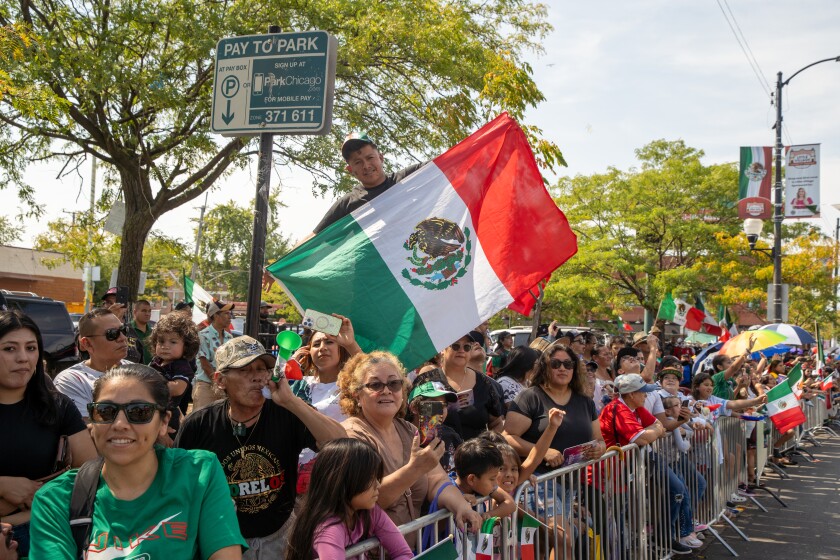From the Chicago Sun Times and WBEZ (2024),
Chicago’s new 'Brown Belt' is populated by Mexican residents who help fuel the area economy, report says,
Researchers say Mexicans are concentrated in the low-wage workforce. They make up more than half of Chicago’s construction laborers and more than 71% of the city’s landscapers.
The findings were highlighted Tuesday at the Latino Research Initiative 2024 Summit, organized by the Great Cities Institute at the University of Illinois Chicago.
“The story of this report is unmistakable: Mexicans were an unheralded part of Chicago’s industrial heyday, they have been a critical part of the city’s remarkable comeback in the post industrial service era, [and] Mexican youth represent a disproportionate share of Chicago’s future,” said Juan González, senior research fellow at the institute.
“It’s time policymakers and city leaders recognize the Mexican contribution to Chicagoland through actions, not just words.”
The report, Fuerza Mexicana: The Past, Present, and Power of Mexicans in Chicagoland, shows a big drop in the population from historic Mexican neighborhoods, like Pilsen and Little Village, and a move to other community areas, most on the Southwest Side.
Tens of thousands of longtime Mexican residents in Pilsen and Little Village were displaced by rising home prices and gentrification, according to the report, and many spread out to nearby neighborhoods. In 2000, six Chicago community areas had more than 50% Mexican population. That list has grown to 15, including a swath of Southwest Side neighborhoods covering Brighton Park, Archer Heights, McKinley Park and New City.
“There’s a ‘Brown Belt’ right here in Chicago,” Gonzalez said, referring to that cluster of communities.
Two Northwest Side neighborhoods, Belmont-Cragin and Hermosa, also have a more than 50% Mexican population.
The report also highlights rapid growth of the Mexican population outside Chicago. Data from the U.S. Census Bureau shows nearly two-thirds of area Mexicans live beyond the city’s borders — more than 450,000 in suburban Cook County and about 514,000 in Will, McHenry, Kane, DuPage and Lake counties. Kane County, which includes the cities of Elgin and Aurora, has the highest percentage of Mexicans among Illinois’ counties, making up more than 27% of its population, the report said.
Daysi Ximena Diaz-Strong, an assistant professor at UIC, said this growth has been years in the making.
“[Latinos] are an established, integral part of their communities [in the suburbs],” but it hasn’t been well documented, Diaz-Strong said. “There was a lack of data on their experiences.”

Researchers say the growth of the Mexican population in the region has helped Chicago’s economy, even if it has primarily meant low-wage jobs for this group of workers.
While some Mexicans have advanced degrees and moved into professional jobs, “the persistent ascriptive assignment of Mexican labor into certain industries and occupations at the lowest wages remains today,” according to the report. Researchers say Mexicans make up more than half of Chicago’s construction laborers, 44% of its cooks, 39% of its janitors, and more than 71% of the city’s landscapers.
“The ability and willingness of [Chicago’s] leaders to keep attracting low-wage Mexican and Latin Americans made possible the city’s economic resurgence,” said González. “Other big Rust Belt cities that did not follow that same approach — places like Cleveland, Detroit and Indianapolis — plummeted in population, economic influence and national economic strength and national influence.”
Other highlights of the report include data showing larger household sizes and a younger median age among Mexican residents compared to the rest of the population, as well as an increase in homeownership among Chicago area Mexicans. Poverty rates also have decreased among the community.
Researchers make several policy recommendations, including increasing affordable housing, helping small business owners, and increasing voter participation among Mexican residents.
The report was commissioned by some local organizations that said a lack of disaggregated data on the area’s Mexicans made it difficult to advocate for resources for the community.
Adrian Soto, executive director of the Greater Southwest Development Corporation, said the new research not only provides insight into the Mexican community, but also puts forth “action plans for us to really start tackling some of the critical issues in our community.”
No comments:
Post a Comment